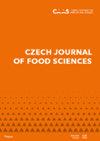Assessment of chemical contaminants in fresh and packaged tender coconut (Cocos nucifera) water
IF 1
4区 农林科学
Q4 FOOD SCIENCE & TECHNOLOGY
引用次数: 1
Abstract
Pesticide residues and heavy metals were analysed in both fresh tender coconut water (FTCW) (n = 161) and packaged tender coconut water (PTCW) (n = 126) samples collected from three southern states of India [Andhra Pradesh (AP), Kerala (KL), and Tamil Nadu (TN)]. A method validated in the laboratory using liquid chromatography-tandem mass spectrometry (LC-MS/MS) was used for pesticide residues, while heavy metals were analysed using a validated method of inductively coupled plasma-optical emission spectrometry (ICP-OES). Significant differences in heavy metal concentrations were assessed using analysis of variance (ANOVA) and post hoc test (between different varieties collected 'within' and 'among' states). FTCW samples [n = 9 (6%)] collected from TN showed Monocrotophos and Malathion residues in the range of 1.0 µg L–1 to 51.6 µg L–1 and 0.5 µg L–1 to 0.6 µg L–1, respectively, while they were detected in n = 5 (4%) of the PTCW samples at a range of 0.90 µg L–1 and 0.82 µg L–1 to 1.56 µg L–1. Heavy metals such as cadmium (Cd), chromium (Cr), lead (Pb), and stannum (Sn) were detected in different varieties collected from all three states. Some of the PTCW samples also contained traces of Cd, Cr, cobalt (Co), and Pb. Arsenic (As) was found in one sample from KL, while none of the samples was contaminated with mercury (Hg). The present study accentuates the need for fixing standards for the pesticide residues in coconut water.新鲜和包装的嫩椰子(椰子)水中化学污染物的评估
对从印度南部三个邦[安得拉邦(AP)、喀拉拉邦(KL)和泰米尔纳德邦(TN)]采集的新鲜嫩椰子水(FTCW)(n=161)和包装嫩椰子水中的农药残留和重金属进行了分析。使用液相色谱-串联质谱法(LC-MS/MS)在实验室验证的方法检测农药残留,而使用电感耦合等离子体发射光谱法(ICP-OES)验证的方法分析重金属。使用方差分析(ANOVA)和事后检验(在“州内”和“州间”收集的不同品种之间)评估重金属浓度的显著差异。从TN收集的FTCW样品[n=9(6%)]显示,单氯膦和马拉硫磷的残留量分别在1.0µg L–1至51.6µg L-1和0.5µg L?1至0.6µg L-1之间,而在n=5(4%)的PTCW样品中检测到的残留量范围为0.90µg L!1和0.82µg L−1至1.56µg L。从这三个州采集的不同品种中都检测到了镉(Cd)、铬(Cr)、铅(Pb)和锡(Sn)等重金属。一些PTCW样品还含有微量Cd、Cr、钴(Co)和Pb。在吉隆坡的一个样本中发现了砷,而没有一个样本被汞污染。本研究强调了确定椰子水中农药残留标准的必要性。
本文章由计算机程序翻译,如有差异,请以英文原文为准。
求助全文
约1分钟内获得全文
求助全文
来源期刊

Czech Journal of Food Sciences
Food Science & Technology, Chemistry-食品科技
CiteScore
2.60
自引率
0.00%
发文量
48
审稿时长
7 months
期刊介绍:
Original research, critical review articles, and short communications dealing with food technology and processing (including food biochemistry, mikrobiology, analyse, engineering, nutrition and economy). Papers are published in English.
 求助内容:
求助内容: 应助结果提醒方式:
应助结果提醒方式:


